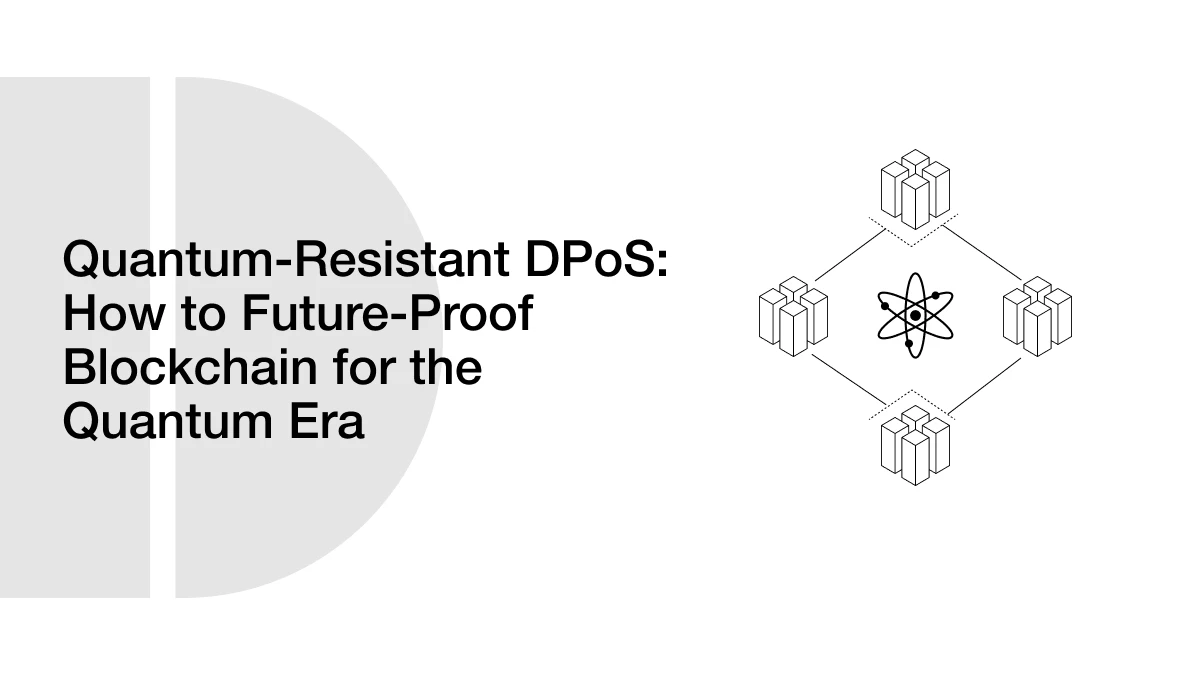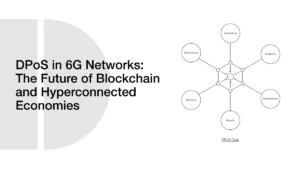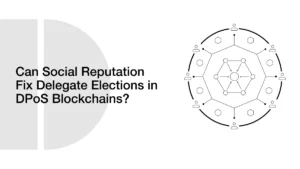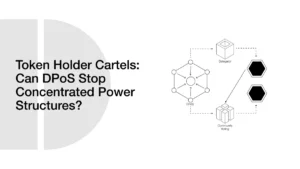Quantum-Resistant DPoS: How to Future-Proof Blockchain for the Quantum Era

Blockchain has grown from a small tech idea into a huge global network that powers digital money, NFTs, supply chains, and even voting systems. One of the most popular types of blockchain is Delegated Proof of Stake (DPoS). People like DPoS because it is fast, low-cost, and uses less energy than other methods like Proof of Work.
- What Does “Quantum-Resistant” Mean?
- Why It Matters for DPoS
- Understanding DPoS in Simple Terms
- How DPoS Works Step-by-Step
- DPoS vs Proof of Work (PoW)
- What is Quantum Computing and Why is it a Threat?
- How Quantum Computing Threatens Blockchain Security
- The “Harvest Now, Decrypt Later” Problem
- How Quantum-Resistant DPoS Works
- Benefits of Making DPoS Quantum-Resistant
- Post-Quantum Cryptography (PQC) in Blockchain
- Normal Encryption vs Post-Quantum Encryption in Blockchain
- Real-World Applications of Quantum-Resistant DPoS
- Challenges in Building Quantum-Resistant DPoS
- How AI Strengthens Quantum-Resistant DPoS
- Preparing Blockchain Networks for the Next Tech Wave
- Key Players in Global Quantum Security Standards
- Conclusion
- Frequently Asked Questions (FAQs)
- Glossary of Key Terms
But now there is a new challenge on the horizon: quantum computing. Quantum computers are not just a faster version of regular computers. They work in a completely different way, which makes them capable of solving problems that would take normal computers thousands of years to complete. That power could be dangerous for today’s blockchains.
What Does “Quantum-Resistant” Mean?
Saying a blockchain is quantum-resistant means that it is designed in such a way that it can withstand attacks by quantum computers. This is significant since the majority of blockchains currently employ encryption procedures that are secure against common hackers but not necessarily against quantum-empowered hackers.
In the absence of quantum resistance, a powerful enough quantum computer could hack wallets, steal coins, and even overtake the voting mechanism of a DPoS network. That is why many experts say that there is a need to upgrade our blockchain security before these computers become common (NIST, 2023).
Why It Matters for DPoS
DPoS blockchains like TRON, Cardano, SUI, EOS, and others are chosen for speed and efficiency. They work by letting token holders vote for delegates who validate transactions. If a hacker were able to hack the voting system through a quantum attack, they could select poor delegates, authorize false transactions, or even prevent the network from operating.
The next step of adding quantum-resistance to DPoS is securing the network in the course of the next 10, 20, or even 50 years. It is not only a matter of staying one step ahead with technology, but also being one step ahead of the threats before they occur.
| Feature | Normal DPoS Security | Quantum-Resistant DPoS Security |
| Transaction Safety | Safe from normal hackers | Safe from normal and quantum hackers |
| Voting Integrity | Protected with current encryption | Protected with post-quantum cryptography |
| Data Lifetime | Safe for a few years | Safe for decades |
| Attack Resistance | Strong against classic attacks | Strong against both classic and quantum attacks |
Understanding DPoS in Simple Terms
Delegated Proof of Stake (DPoS) is a way for blockchains to agree on transactions. In a DPoS system, people who own tokens can vote for a small group of trusted members called delegates or validators. These delegates are responsible for checking and approving transactions.
Instead of all of them doing the work, as in the case of Bitcoin Proof of Work, only the elected delegates do it. This renders DPoS much quicker, more affordable, and less power-consuming. This is why it is used in many contemporary blockchains.
How DPoS Works Step-by-Step
- Token holders vote – The more tokens you have, the more voting power you get.
- Top delegates are chosen – Usually, the top 21 or so become active validators.
- Validators confirm transactions – They create and add blocks to the blockchain.
- Rewards are shared – Validators get rewards, and sometimes they share them with voters.
This system is like electing representatives in a democracy. The delegates work for the network, but token holders can replace them at any time if they fail to perform well.
- Speed – Transactions are confirmed in seconds and not in minutes.
- Low fees – A lower computing power translates to low fees.
- Environmentally-friendly – Consumes much less energy than mining in Proof of Work.
- Flexible governance – Token holders can modify the rules by voting.
However, as efficient and quick as DPoS is, it relies on encryption to secure votes and transactions. In case of failure in encryption, such as in a future with powerful quantum computers, the entire system may be endangered.
DPoS vs Proof of Work (PoW)
| Feature | DPoS | Proof of Work (PoW) |
| Speed | Very fast (seconds per transaction) | Slow (minutes per transaction) |
| Energy Use | Low | High |
| Number of Validators | Small group of elected delegates | Thousands of miners |
| Governance | Token holders vote for delegates | No direct voting |
| Security Risk | Relies on encryption and voting honesty | Relies on mining difficulty and power |
What is Quantum Computing and Why is it a Threat?
A normal computer works with bits. Each bit can only be a 0 or a 1 at any moment. Your phone, laptop, and servers all use this system. A quantum computer uses something different called qubits. Qubits can be 0, 1, or both at the same time. This special ability is called superposition.
Quantum computers are also able to entangle qubits. This implies that as soon as you modify one qubit, the others are modified, regardless of the distance between them. The two concepts, superposition and entanglement, allow quantum computers to solve some problems in a fraction of the time that normal computers can.
How Quantum Computing Threatens Blockchain Security
Most blockchain security today depends on very hard math problems. Examples include:
- RSA encryption – Based on factoring huge prime numbers.
- ECC (Elliptic Curve Cryptography) – Used in Bitcoin, Ethereum, and many DPoS networks.
A normal computer would take thousands of years to solve these problems. But a powerful quantum computer running Shor’s algorithm could solve them in hours or minutes.
This means that, in the future, a hacker with a strong quantum computer could:
- Steal coins from wallets by cracking private keys
- Alter blockchain history by faking transactions
- Take control of DPoS voting by forging signatures
The “Harvest Now, Decrypt Later” Problem
A scary part about quantum threats is that attackers don’t have to wait for a working quantum computer to start stealing. Right now, hackers can collect and store encrypted data from blockchains, government systems, or banks.
This is called Harvest Now, Decrypt Later (HNDL). Quantum computers will be able to revisit that data and decrypt it all when they are ready. This poses a particular threat to such industries as finance, defense, and healthcare, where data has to remain safe for decades.
| Feature | Normal Computer | Quantum Computer |
| Basic Unit | Bit (0 or 1) | Qubit (0, 1, or both at once) |
| Key Technology | Transistors | Quantum mechanics |
| Processing Style | One calculation at a time | Many calculations at the same time |
| Encryption Breaking | Thousands of years for RSA/ECC | Hours or minutes for RSA/ECC (in theory) |
| Blockchain Risk | Low | High if quantum-resistant measures are not used |
How Quantum-Resistant DPoS Works
A quantum-resistant DPoS would maintain the same speed and voting mechanism that people enjoy, while improving security to resist a quantum attack. It does that by applying new encryption techniques and even combining them with old ones.
In such a manner, even with a quantum computer, a hacker will not be able to access wallets, alter votes, or edit the blockchain.
By using all three, DPoS networks can block both today’s hackers and future quantum hackers. In a DPoS system, voting is the heart of the network. If voting is hacked, the whole system can collapse. With quantum-resistant methods, the votes are safe, and transactions can’t be changed or faked. This keeps the network fair, honest, and trusted for years to come.
- Post-Quantum Cryptography (PQC) – This is new math that is safe even against quantum computers.
- Quantum Key Distribution (QKD) – This uses quantum physics to send secret keys in a way that makes hacking almost impossible.
- Hybrid Encryption – This combines old and new encryption, so there is backup protection.
| Tool | What It Does | Why It’s Safe Against Quantum Attacks |
| Post-Quantum Cryptography | Uses math problems quantum computers can’t solve | Makes wallet keys and signatures safe |
| Quantum Key Distribution | Sends encryption keys using quantum physics | Any hack attempt changes the key instantly |
| Hybrid Encryption | Combines old and new methods | Gives two layers of defense |
Benefits of Making DPoS Quantum-Resistant
Quantum-resistance of DPoS introduces safety to the network in the long term. Currently, most blockchain systems use encryption that is powerful against ordinary computers. This implies that such systems can be broken when quantum computers are powerful enough. The quantum resistance is added to make both the present and the past data secure even in a post-quantum world. In the case of DPoS, which relies on voting and trust of delegates, it implies that the decision-making process cannot be influenced by any external party.
ALSO READ: How Can Micro-Delegation in DPoS Blockchains Empower Retail Investors
The other advantage is that it instills confidence in users and investors. When individuals are aware that a blockchain cannot be hacked by current hackers and also future quantum attacks, they will tend to trust it to hold their money, data, and votes. This trust results in increased adoption, more community strength, and greater network stability. It also appeals to institutional users, including banks, governments, and large corporations, which need robust assurances of long-term data security.
Quantum resistance is also resistant to the “Harvest Now, Decrypt Later” attacks. Although a person may collect encrypted blockchain data now, they will not be capable of decrypting it later. This makes sensitive transactions, personal information, and voting records not only secure in the current times but secure decades later. Quantum-resistant DPoS is an investment in the future of the network, as it will remain reliable, trustworthy, and secure long into the quantum future.
Post-Quantum Cryptography (PQC) in Blockchain
Post-Quantum Cryptography (PQC) is a type of encryption made for a future where quantum computers are real and powerful. It uses math problems that even quantum computers can’t solve easily. The goal is to protect data now and for decades, so even if someone stores your encrypted data today, they won’t be able to crack it in the future.
There are different kinds of PQC algorithms, but the most common are Lattice-based cryptography, Hash-based cryptography, and Multivariate polynomial cryptography. The National Institute of Standards and Technology (NIST) is already testing and approving PQC algorithms for public use. For blockchains like DPoS, PQC replaces old encryption with quantum-safe methods. This means:
- Wallets stay safe from key theft.
- Voting stays fair and can’t be faked.
- Old transaction data stays secure for decades.
Without PQC, quantum hackers could one day steal tokens, change voting results, or shut down the network.
Normal Encryption vs Post-Quantum Encryption in Blockchain
| Feature | Normal Encryption | Post-Quantum Encryption |
| Safety Against Hackers | Safe against normal computers | Safe against normal and quantum computers |
| Long-Term Security | Might fail in 5–10 years with quantum | Safe for decades even with quantum advances |
| Blockchain Use | Current wallets and transactions | Future-proof wallets and transactions |
Real-World Applications of Quantum-Resistant DPoS
Quantum-resistant DPoS is not only a concept of the future. It has already found definite applications in numerous industries. In the financial sector, it has the potential to safeguard banks and digital asset exchanges against current hackers and quantum threats in the future. Financial transactions may require remaining safe for decades, and even one breach may cost millions. Having PQC and QKD integrated with DPoS systems, banks will be able to make payments, give loans, and handle investments without fearing that transaction data stored in their databases will be stolen several years later when quantum computers are more powerful.
In the healthcare industry, personal data such as patient medical records, diagnostic histories, and genomic data should be confidential throughout their lifetimes. Quantum resistance can be added by hospitals and research labs using DPoS to manage this data to ensure that it is safe even when hackers gather it now and intend to crack it in the future. This is particularly relevant in long-term studies and medical research projects where the integrity of the data is paramount.
| Industry | Current Use | How Quantum Resistance Helps |
| Finance | Online banking, crypto exchanges | Keeps transactions and records safe for decades |
| Healthcare | Patient records, medical research | Protects sensitive data from future decryption |
| Government | Voting systems, defense communication | Stops vote tampering and classified data theft |
Governments can also benefit by using quantum-resistant DPoS for voting systems, public records, and defense communication. A secure DPoS system could manage national elections without fear of vote tampering. Any interception of classified defense information and infrastructure control systems could be prevented. Governments can ensure that their critical digital services remain trustworthy and stable by preventing present and future cyberattacks.
Challenges in Building Quantum-Resistant DPoS
Making a DPoS network quantum-resistant requires far more than a quick code update. It often means replacing core cryptographic systems, changing how wallets store keys, how transactions are signed, and how voting data is secured. Most blockchains are based on conventional encryption, so transitioning to post-quantum cryptography may require years of painstaking effort to prevent destroying the current systems. It is also expensive and may require new hardware, improved infrastructure, and developer and validator training. The changes might also create new security vulnerabilities rather than address them without testing.
Adoption is another barrier. In decentralized systems, major updates are normally done through a vote. Even in cases where the developers are aware of the urgency, the token holders might not comply because of the costs involved or the length of the timeline, or the fear of losing compatibility with other blockchains. To overcome this, one needs good leadership, proper planning, and communication on the dangers of delaying. The most promising quantum-resistant technology can never be fully adopted without being widely supported. To overcome these challenges, planning, good leadership, and communication need to be done to explain the risks of not upgrading.
How AI Strengthens Quantum-Resistant DPoS
| AI Function | How It Helps | Benefit for the Network |
| Threat Detection | Spots unusual voting or transaction behavior | Stops attacks before they cause damage |
| Encryption Testing | Finds weaknesses in PQC algorithms | Ensures only the strongest methods are used |
| Performance Optimization | Balances speed and security in the network | Keeps transactions fast and reliable |
Preparing Blockchain Networks for the Next Tech Wave
The best way for blockchain networks to handle quantum threats is to prepare early. Waiting until quantum computers are powerful enough to break current encryption could leave very little time to respond. A smart first step is to test the network’s existing security to find any weaknesses that quantum attacks could exploit. This can be done through security audits and simulations designed to mimic quantum-style hacking. Once vulnerabilities are identified, developers can start adding post-quantum cryptography to wallets, voting systems, and transaction processes. Using a hybrid approach during this stage, combining traditional encryption with quantum-safe methods, can help keep systems compatible with other blockchains while reassuring users that their data remains secure during the upgrade.
ALSO READ: The Future’s Here | How Multi-Chain DPoS Voting Could Optimize Electoral Processes
Community involvement is also crucial for DPoS networks. Token holders, validators, and developers need to work together to approve and carry out these changes. Clear communication about the risks posed by quantum computing, supported by examples of the benefits of quantum-resistant technology, can make it easier to reach an agreement. When the community understands why these upgrades matter, decisions can be made faster and implementation can move more smoothly. Preparing now greatly improves the chances of keeping the network secure and trustworthy when the next wave of technology arrives.
Key Players in Global Quantum Security Standards
| Organization | Role | Impact on Blockchain |
| Quantum Cybersecurity Preparedness Act | Requires U.S. federal agencies to adopt PQC | Sets legal framework and urgency |
| NIST | Develops and approves PQC algorithms | Provides tested, trusted encryption methods |
| Private Cybersecurity Companies | Create and deploy quantum-safe tools | Makes technology available for blockchain use |
| International Research Partnerships | Share findings and develop global standards | Ensures worldwide compatibility |
Conclusion
Quantum computing will bring major progress in science, finance, and technology, but it will also create serious risks for digital security. Blockchains, especially those using Delegated Proof of Stake, must be ready for this change. Quantum-resistant DPoS is the way to protect voting systems, transactions, and stored data from future attacks.
By adopting post-quantum cryptography, quantum key distribution, and AI-powered monitoring, DPoS networks can remain secure for decades. The cost and effort of upgrading are small compared to the risk of losing trust, funds, and vital data. The next tech wave is coming fast, and those who prepare early will lead the future of secure, decentralized systems.
Frequently Asked Questions (FAQs)
- What does quantum-resistant mean for blockchain?
Quantum-resistant means a blockchain uses encryption methods that even powerful quantum computers cannot break. - Why is DPoS more at risk from quantum attacks?
DPoS depends on voting and encryption to choose validators. If encryption is broken, hackers could take over voting and control the network. - Can quantum computers hack blockchains right now?
Not yet, but experts believe they could within the next 5–10 years, so preparation is important now. - What is Post-Quantum Cryptography (PQC)?
PQC is a set of encryption algorithms designed to be safe from both normal and quantum computer attacks. - How does Quantum Key Distribution (QKD) work?
QKD uses quantum physics to send encryption keys in a way that shows if anyone tries to intercept them.
Glossary of Key Terms
Delegated Proof of Stake (DPoS): A blockchain system where token holders vote for delegates who validate transactions.
Quantum Computer: A type of computer that uses quantum mechanics to solve problems faster than normal computers.
Post-Quantum Cryptography (PQC): Encryption that remains secure even against quantum computer attacks.
Quantum Key Distribution (QKD): A method of securely sending encryption keys using quantum mechanics.
Harvest Now, Decrypt Later (HNDL): A hacking strategy where encrypted data is stolen now and decrypted in the future using stronger technology.




